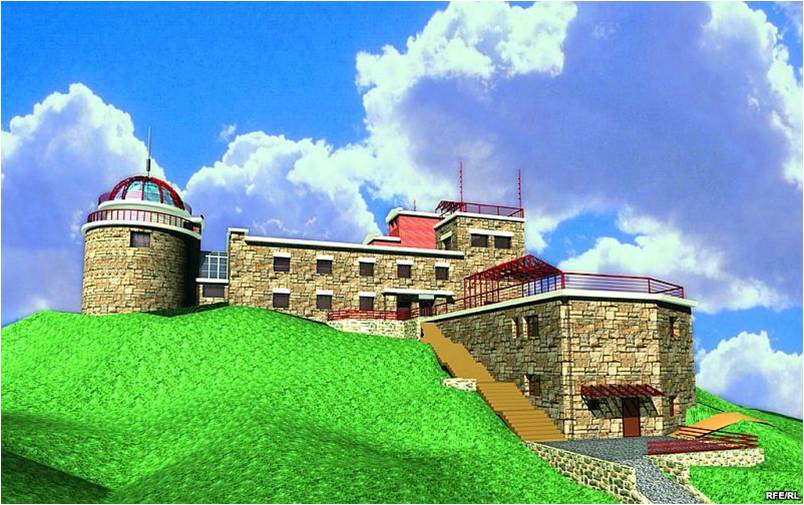ХХ century
1935
Engineer, General Leon Berbecki came up with the idea to construct the observatory on Pip Ivan. He suggested to the Head of the Airborne and Antigas Defence League of Poland (LOPP) and to the director of the Astronomical Observatory at the
There were a lot of discussions as to the construction. Namely, the question of where the structure should be built, on Hoverla or on Pip Ivan (also called
One of the oldest documents where Black Mountain is mentioned is the map «Deliniatio specialis et accurata Ukrainae cum suis palatinatibus ac distictibq provincysq adiacentibus» of 1651, which was compiled by de Boplan, a French military architect and captain of the Polish king.
Leon Berbecki is said to have personally indicated the place where the observatory was supposed to be erected, and a closed competition was held for the project of "Marshal Józef Piłsudski astronomical observatory". The project committee gave the highest score to the project by architects and engineers Kazimierz Marczewski and Jan Pogoski from the Regional construction department of Podhale and Hutsulshchyna. According to the organisers it met their requirements best. Namely, in terms of the use of the local stone for construction, sustainability, harmony of the construction with the environment, and most importantly, it took into consideration the severe climatic conditions of the Carpathian Highlands. Later on, when people abandoned it, the locals called the observatory "The White Elephant", because of the nearly total frosting-up during winter, which thus resembled a castle made of ice.
The style of this project was similar to the works of the architectural
Nearly
Scholar Yaroslav Zelenchuk writes that "no one could deliver building materials more than twice a day in summer. One delivery of cargo cost 12 zloty (you could earn 24 zloty a day), while the work of a lumberjack cost 5 zloty a day, a haymaker made 2 zloty a day, a weeder or a grubber made 1 zloty a day. A martin fur cost 120 zloty, a cow cost 100-150 zloty,
1938
Over the period of two years, on the top of the mountain there appeared a building shaped as a mirror image of the Latin letter L. In those times, it was described as “monumental”. The walls made from limestone blocks were 1.5 meters thick. The building had five floors, 43 rooms and 57 windows.
The gable roof was covered with a tinplate sheet shining like gold. It was an impressive sight for the Hutsuls. The two floors in the eastern side and the five floors in the western side of the building made it look like a magnificent unassailable fortress. In the southern part of the observatory, there was a rotunda with an astrograph.
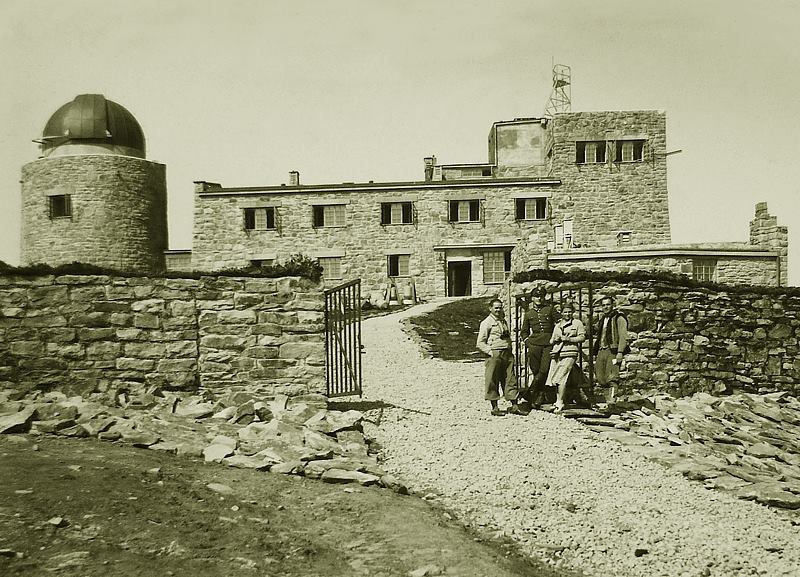
The observatory was launched on 29 July 1938. It was used for both astronomical and meteorological purposes. The astronomical department was a branch of the Astronomic Observatory at the University of Warsaw; the meteorological department was part of the National Institute of Meteorology in Warsaw. Admission was by pass signed by the director of the National Institute of Meteorology in Warsaw.
The Observatory was headed by Władysław Midowicz (born in 1907 in Mykulychyn), who was a Polish geographer and meteorologist; he had run a tourist shelter in the Beskids. The man was passionate about his job. Thus as everybody who gave their heart to the project, Midowicz moved to the observatory together with his wife Antonina and five-year-old son Yatsek.
Back then, the Pip Ivan Observatory was one of the most significant in Europe. The 33-centimetre astrograph produced by the British company “Sir Howard Hrabb Parson & Co” was set in motion by engines automatically controlled by a chronometer. The astrograph was located inside a dome, which was six meters in diameter; the dome was also moved by engines. Astronomical observations were made through the opening in the dome.
The astrograph was mounted by Maciej Bieliński, who was also the first to use it in order to check its accuracy in November 1937. Bieliński managed to take four photographs of 704 Interamnia. A few months later, the astrograph captured two images of Comet Jurlof-Achmarof-Hassel. These achievements were recorded in journal publications. All the other materials were lost.
Meteorological observations were made by Franciszek Wiatr, Bernard Liberra, Stefan Schyrbak. The latter also made approximately 70 visual estimates of the brightness of twinkling stars, took a series of pictures showing the rotation of Mars and identified six positions of Comet Brooks. He spent around twenty hours searching for new comets with the help of a 80-millimetre telescope.
Owing to the fact that the mountain lay across the Poland -Czechoslovakia border, (since 1939, at the Poland-Hungary border), it was decided to create a border protection corps there (Polish: Korpus Ochrony Pogranicza, KOP).
1939
Unfortunately, the observatory functioned for one year only. On September 1st, 1939 the World War II began.
Vladyslav Midovych had the special envelope with the instructions on how to act in case of war. The first thing to do was to burn down the entire secret chancellery, destroy all the equipment not removed in time so as to deprive the enemy of the possibility to benefit from it, pay all the workers three months’ salary.
The chancellery was destroyed as well as the part of the astronomic equipment. But not following the instruction, he didn’t break the astrograph. He made a wooden box stuffed with hay where he hid it. Before descending to the Hungarian side he gave the money to the principal technician Yurii Chornyi. He gave him a pistol with charge, ordering him to shoot everyone trying to rob the observatory. Though Midovych took the main key to the building with him.
A big group of people led by Yurii Chornyi had continued living in the observatory for several years until the Hungarian army came. The Hungarians turned “The Hutsul Piramid” into the frontier fortress which survived till 1944.
Midovych immigrated to
On December 31st, 1939, the academician of NAS of the USSR Olexandr Orlov, the first person in the
Later, everything left there by Yurii Chornyi and the Poles was stolen. First of all the copper sheets disappeared from the roof. All the bells on the necks of local cows and the frugal hutsuls’ vats for banosh are said to have been made of the copper from the observatory roof.
1963
That year the observatory was remembered of again. Ivano-Frankivsk organization “Oblproekt” explored the site. At that time lots of things were still retained, so in response to the specific order of the Committee for State Security of the USSR the organization worked out a complex project report.
The project report of 1963 included not only renovation but also expansion and the construction of additional facilities, namely a large accumulator station. They even planned to build a big vegetable storehouse for staff needs. Large fuel oil residue storage tanks were intended to be installed to provide for the needs of the boiler station. According to the project, they were to construct a gas generator plant, a water supply system, a maintenance building, a helicopter lot, and even a site for the installation of radio aerial. The plans were grand.
But the final aim of the project site failed to be determined. The project documentation was completely prepared, but at a certain stage, they decided not to implement the project. It was, possibly, due to the location of a radar station in Mukachevo.
1991
At the beginning of the 1990’s in the independent Ukraine, Ivano-Frankivsk Regional State Administration returned to the idea of reconstructing the observatory.
In 1995-1997, the project documentation was drafted including different elements of expansion. But further on it was still not used by developers for the construction.
ХІ century
The Observatory of Today
The new idea of reconstructing the Observatory and assigning new objectives and tasks to it was generated from the vision shared by the Center for the East European Studies at the University of Warsaw and Vasyl Stefanyk Precarpathian National University.
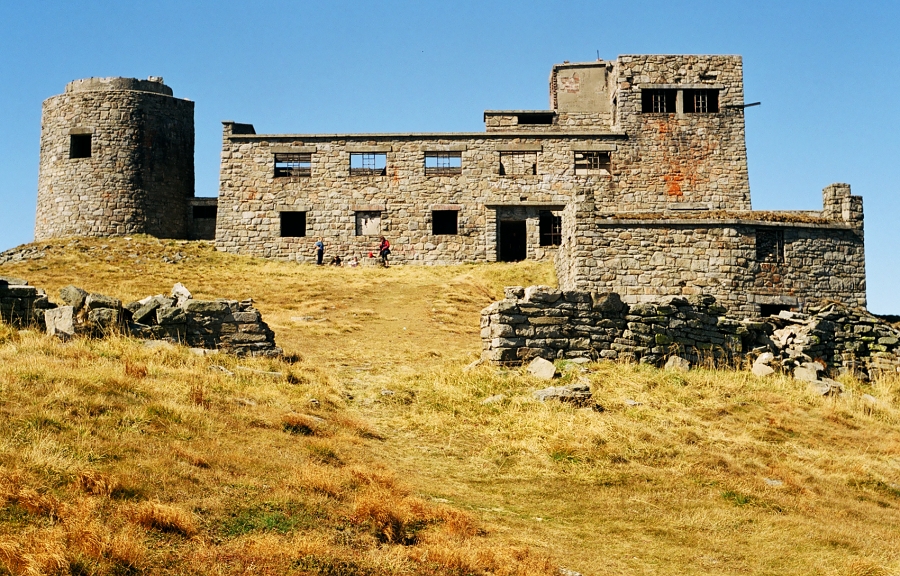
This site as one of the elements of the project “
Verkhovyna Raion Rada and Ivano-Frankivsk Oblast Rada resolved to hand the site over to
Starting from 2012, the reconstruction of the site is financed on a regular annual basis. A large proportion of the work was funded by the Ministry of Culture and National Heritage of the
The historic date is considered September 04, 2012 when the first construction load and crew were taken to the top of the mountain. There is no doubt that the beginning of the revival of the Hutsul Pyramid was fantastic. The observatory had been neglected for so many years. It had been destroyed by wind, rain, snow, and people.
During the first stage, the site was only mothballed. The windows of the both floors were bricked; the wooden boards were partly restored. At the same time, the building was being prepared for roofing. It was a real wonder: the neglected fortress was miraculously transformed from the landfill and public lavatory into a construction site.
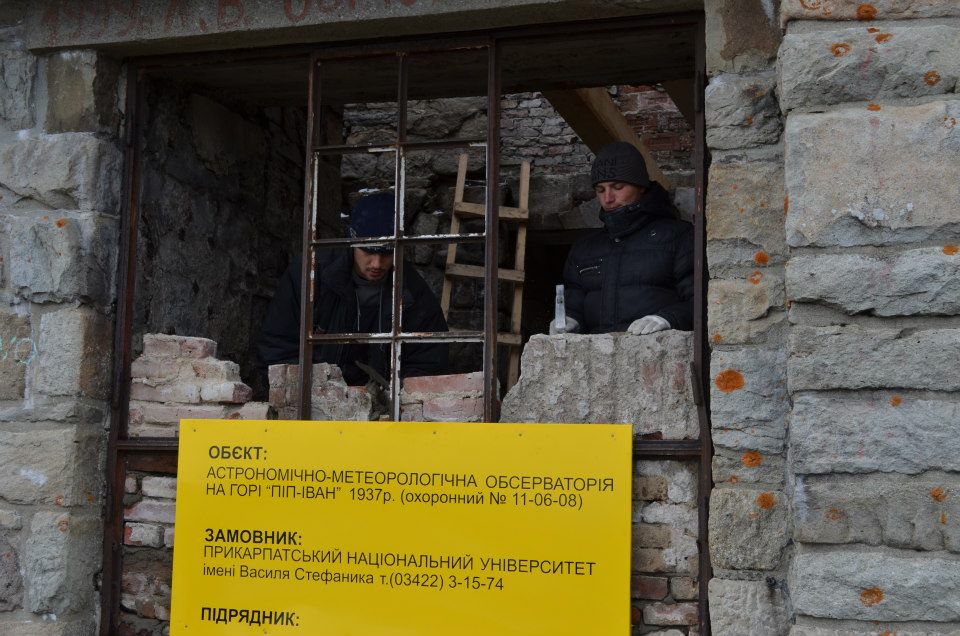
The process of taking construction materials in a GAZ-66 instead of the Hutsul horses did not get much easier than it was in 1936.
The rooms were cleared little by little. The garbage, which piled up for almost 70 years and was higher than a person, absorbed and retained so much humidity that when the workers got to the bottom layer, they found ice. And it was in the middle of the summer!
To prevent the windows and other openings of the building from being covered with snow, they were bricked up. Step by stem, the decayed floors were removed, and the new flooring and roof framing were installed. The roof above the framing was covered with brass plate.
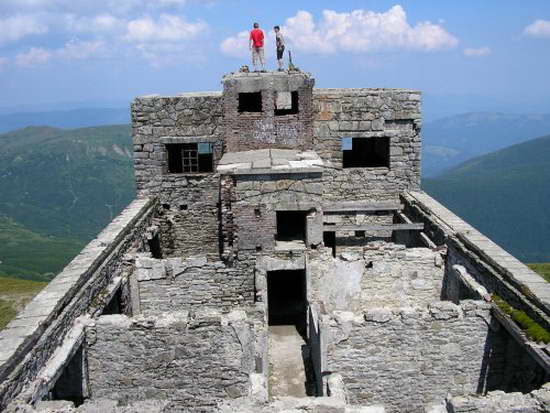
The brass roof became a symbol of revival.
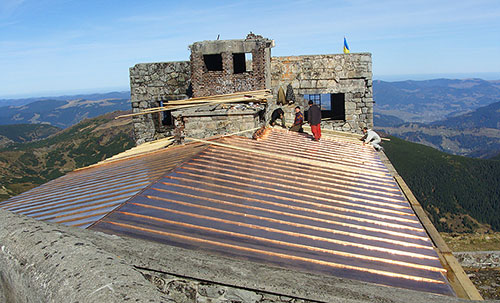
One more historic event was July 07, 2013 when the agreement on establishing a separate rescue station of the Department for Emergency Situations in some of the observatory rooms was signed.
The same year, the frame of metal and wood was installed for a temporary shed above the tower where the telescope used to be.
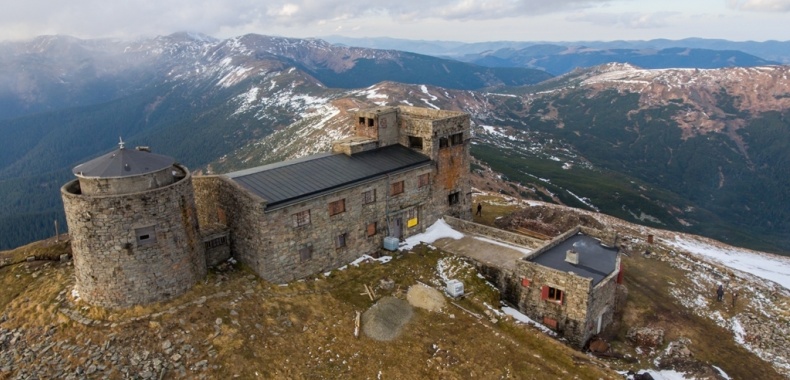
With time, the reconstructors gradually gained their own experience in working under the difficult conditions of high mountains. In the process of reconstruction, a considerable part of the eroded brickwork of the northern tower wall was bricked anew. The off-set system was mounted all round the roof.
The stone wall started to be built round the Observatory; the gate was installed.
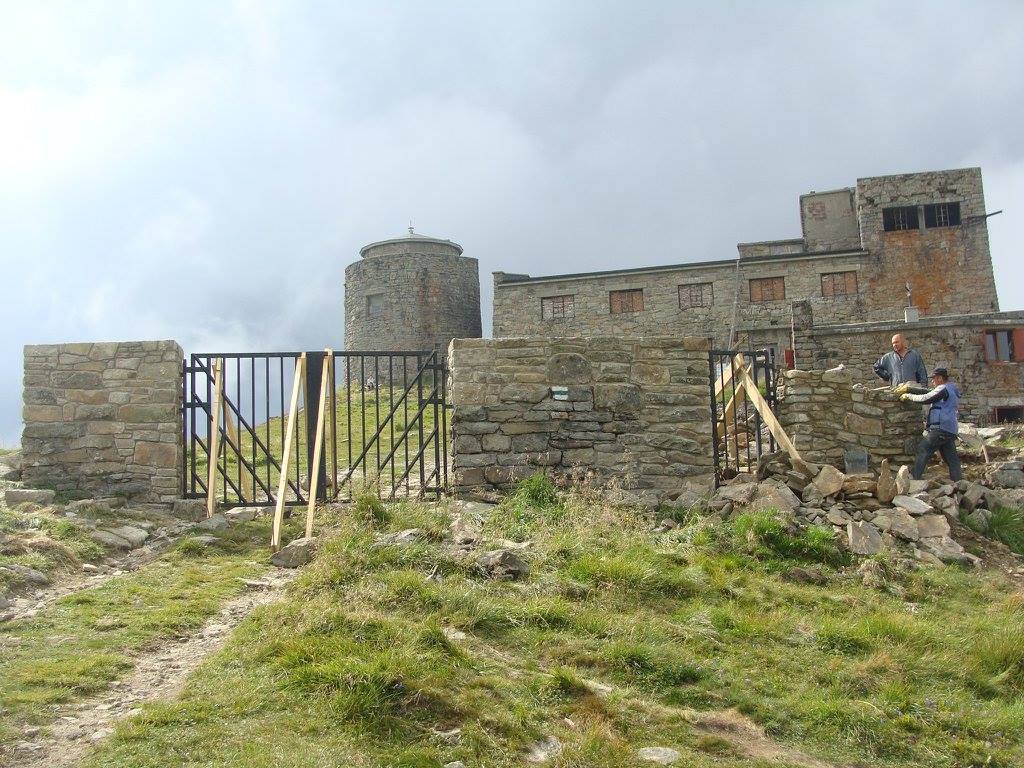
Besides, the temporary facilities were arranged for tourists and workers.
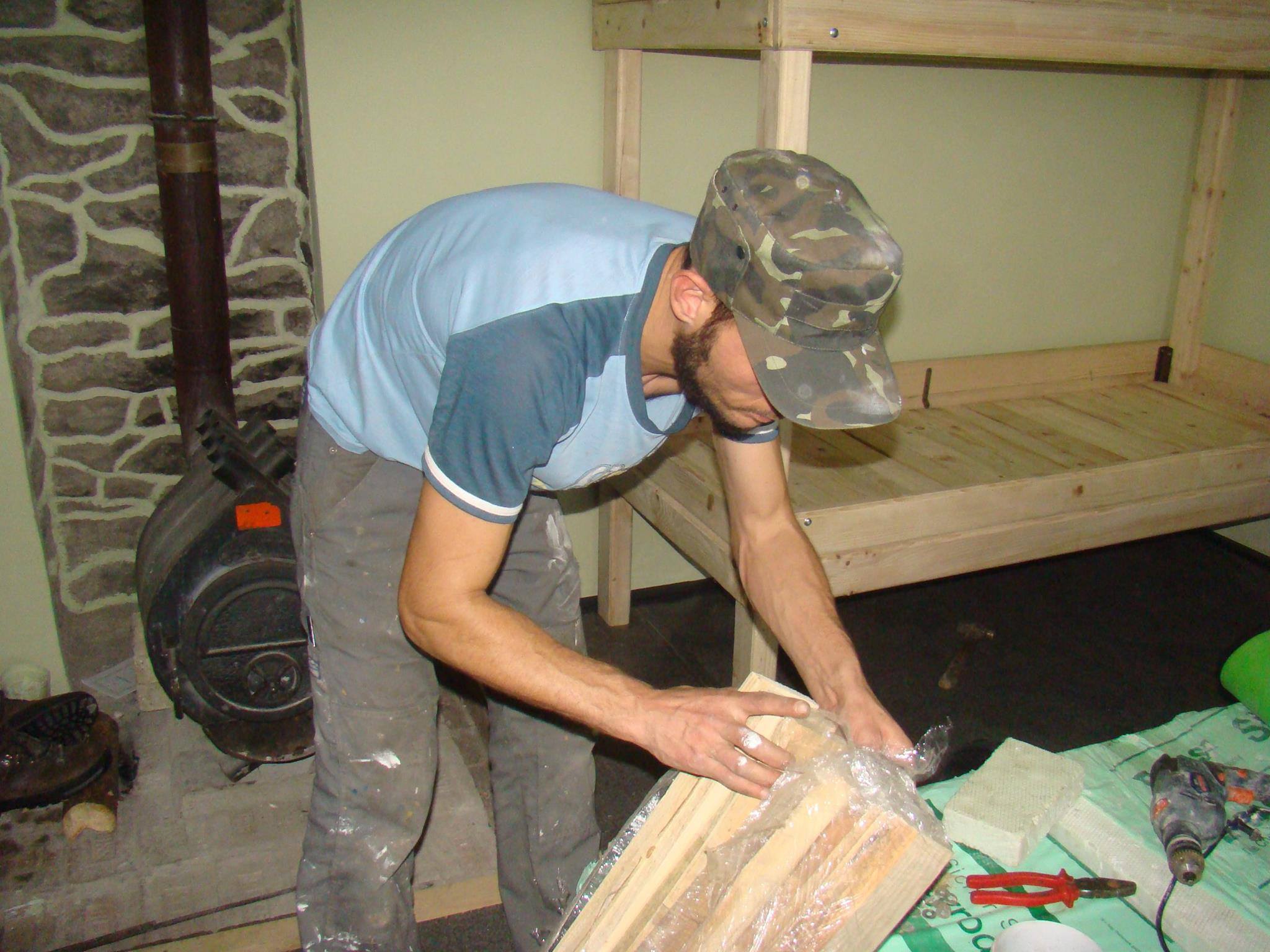
The restored maintenance buildings began to host permanent tenants, i.e. rescuers.
The architects from
In the cleared facilities, one can see the authentic tiles and elements of the former interior which survived vandals and nature.
Now the further reconstruction of the inside of the building is being prepared.
The International Research Center “Observatory” established with the combined forces of Vasyl Stefanyk Precarpathian National University and the Center for the East European Studies at the University of Warsaw will be used not only for astronomical or meteorological observation. Taking into account its location on one of the tallest peak of the Chornohora range of the Ukrainian Carpathians, the site can have a variety of uses. A completely new area is mountain rescue – a rescue station at the Observatory managed by the State Emergency Service of Ukraine in cooperation with the GOPR-Biesczady. One more area of use is organization of Polish, Ukrainian and international research, both individual and group ones, as well as students’ training in biology, botany, nature study, geology, astronomy, geography, meteorology, climatology, tourism, etc.
